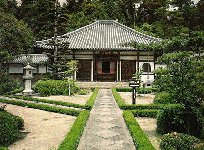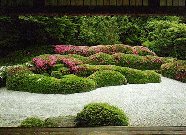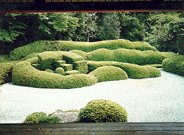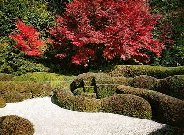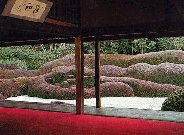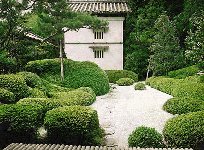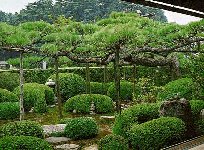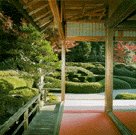
The Horai garden at Daichiji is maintained by Shimizu Toshiharu, a
priest who teaches social
studies at nearby Shirayama Middle School. His wife is usually the one
to show people around,
though. As one walks along the corridors to the viewing pavilio n, two
things are striking: the
strong smell of cypress and an odd plunk....plunk....plunk....coming
from the loudspeakers
attached to the ceiling. The former is from recent construction work. On
February 2, 1993, a
particularly heavy snow caused the roof of the main hall to cave in. The
building has since been
entirely rebuilt in cypress to the precise dimensions of the original.
The latter, an acoustic addition
to the viewing experience, is an amplified recording of water dropping
into a suikinkutsu echo
chamber. The original concept of the garden was also an acoustic one.
The smooth, soft sound of
the wind blowing through the pines growing on the site in th e 17th
century was a reminder of the
sea and islands depicted in the garden.
The walk along the corridor is short and one soon arrives at Horai
Teien. A massing of shaped
green azaleas set against the natural (though constructed) hillside
behind and white sand below is
the primary feature of the garden. (plan to be attached) Marc Trieb sees
the Horai garden as an
example of the juxtaposed modes of formality (shin, gyo, so) that "have
served as a generative
force behind much of Japanese art and environmental design." The shea
red okarikomi shrubs
suggest a treasure ship being tossed among undulating waves of the sea.
Azalea cubes and spheres
form the treasure in the ship piled around the almos t invisible stones
that are said to represent the
seven gods of fortune. To the right of the ship's prow is a separate
rounded mass of azalea with a
protruding stone forming a turtle-shaped kameshima beneath the eaves of
the building. Behind the
kameshima, running perpendicular to the viewing platform and providing a
geometric counterpoint
to the waves is a line of hinoki (cypress). In the foreground below the
viewing pavilion's steps, is a
round, flattened stone flanked by two more small azaleas. This is meant
to provide a place for
zazen meditation while viewing the garden.
The purplish-brown of winter foliage gives way to a bright floral
display from late May to mid
June. This becomes lush green foliage by August and September. In
autumn, the momiji maple
trees on the hillside behind burst into flame.

The garden was built in the early decades after the Tokugawa government
restored peace and
stability at the beginning of the 17th century. It is unclear, however,
precisely when the garden was
constructed. The current pamphlet and interpretive signs both claim
Kobori Enshu (1579-1647)
himself designed the garden in the late 1620's. This is certainly
possible, but, like many of the
gardens with which Enshu is credited, his connection here is debatable.
Th e temple was still in
ruins during Enshu's lifetime and it seems unlikely the
garden would have been built
before the temple buildings were restored in. This did not occur until
twenty years after Enshu's
death. In fact, a number of referenc es refer to his grandson being
responsible for this garden.
Enshu's fame as a designer and arbiter of taste was so profound, it was
not unusual for successive
generations of designers to adopt his name, thereby lending legitimacy
to their work.
The juxtaposition of an okarikomi azalea garden sandwiched between
temple buildings and a
hillside is not unique to this garden. The garden at Raikyuji temple in
Okayama is structurally quite
similar, the only differences between the two being the sli ghtly
earlier construction data at Raikyuji
and the sharper, more choppy lines of the topiary. The smoother lines at
Daichiji probably reflect
the lesser role of the stone insertions.

 |
The temple at Daichiji dates back 1200 years to its 8th century founding
by Gyoki (670-749), a
prominent Korean-born priest that travelled extensively spreading the
Buddhist doctrine.
While the karesansui of Horai Garden is the most significant feature on
the temple grounds today,
it is one of the more recent transformations of the site. Gyoki is
thought to have originally dug a p
ond here in the shape of the Chinese character kokoro (heart/soul/mind.)
Similar kokoro ponds
(see Saihoji) have appeared in numerous Japanese gardens, even to the
present, but they appear
to have been particularly popular in the latter centuries of the Heian
period (794-1185) after the
importation of Buddhism from China (538AD). The first temple building
was erected on an island
located in the center of this pond. An unusual feature was the pond's
use as an irrigation resevoir
for nearby fields. The pond no longer exists, however, and the
irrigation function is now served by
two much larger resevoirs just to the west and northwest of the temple
grounds. The temple was
known as Kantansan Seirenji in these early centuries and was established
as a pray er site for
protection of the state.
In the early 1320's the temple changed hands from the Tendai branch of
esoteric Buddhism to a
Zen sect based at Kyoto's Tofukuji Temple. Long neglected, the grounds
were restored and seven
additional structures added.
In 1577 the entire temple was burned to the ground during one of many
military campaigns that
would eventually lead to the reunification of Japan under the Tokugawa
regime. The temple was
restored until 1667 to celebrate the completion of Minakuchi-jo Castle
nearby. The present
Buddha Hall(butsuden), chashitsu, and priest's quarters (hojo) date from
this time. The name of the
temple was also changed at this point. Its proximity to two large
resevoirs lent inspiration for its
present appelation, Dai chiji, the "Temple of the Large Pond."
In addition to Horai Teien, a second garden between the teahouse and
storeroom contains pines
resembling dancing cranes. The storehouse background is kept whitewashed
to reflect the moon
during evening tea ceremonies, creating the illusion of an open garden
in a very confined space.
Here, the garden is an abstraction of a mountain view with a stream
flowing through a valley.
Other examples of clipped karikomi appear around an ancient (over 300
years old) pine tree in
the foregarden at the entrance of the temple. While the venerable pine
tree has been there for
some time and is qu ite impressive, the entrance garden is a 20th
century addition of little note.




